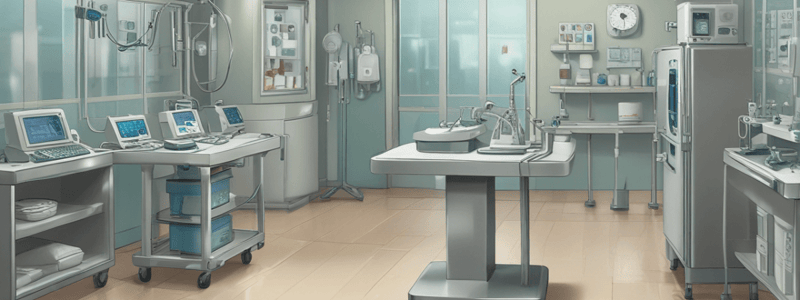Podcast
Questions and Answers
How should devices in a surgical instrument tray typically be arranged?
How should devices in a surgical instrument tray typically be arranged?
- By size, with the largest devices first
- By frequency of use
- By alphabetical order
- From left to right in the order they are required in a procedure (correct)
Why should forceps be placed on instrument pins?
Why should forceps be placed on instrument pins?
- To hold them together and reduce tangling (correct)
- To prevent them from getting lost
- To make them easier to sterilize
- To separate them from other devices
What should be done with devices that require special sterilization methods?
What should be done with devices that require special sterilization methods?
- Consult with a supervisor
- Sterilize them in a separate tray
- Follow the manufacturer's IFU (correct)
- Use a standard sterilization method
Why should devices with ratchets be left open?
Why should devices with ratchets be left open?
What should be done with plastic items in a surgical instrument tray?
What should be done with plastic items in a surgical instrument tray?
What should be done if a missing or extra device is found while assembling a surgical instrument tray?
What should be done if a missing or extra device is found while assembling a surgical instrument tray?
What should be done if a small percentage of RMD in a load were not cleaned and/or dried effectively?
What should be done if a small percentage of RMD in a load were not cleaned and/or dried effectively?
What is checked during the inspection of devices unloaded from the washer-disinfector?
What is checked during the inspection of devices unloaded from the washer-disinfector?
Why is it important to inspect devices under magnification?
Why is it important to inspect devices under magnification?
What should be reported immediately to the supervisor?
What should be reported immediately to the supervisor?
What is the purpose of function testing telescopes and light cables?
What is the purpose of function testing telescopes and light cables?
What is the importance of checking cannulated devices?
What is the importance of checking cannulated devices?
What is the primary function of the assembly area in the CSSD?
What is the primary function of the assembly area in the CSSD?
Who should perform the job of inspecting and preparing surgical instruments in the assembly area?
Who should perform the job of inspecting and preparing surgical instruments in the assembly area?
What is the purpose of maintaining a positive pressure in the IAP room?
What is the purpose of maintaining a positive pressure in the IAP room?
What is the recommended temperature range for the IAP room?
What is the recommended temperature range for the IAP room?
Why is it important to use smooth, non-porous materials for furniture in the IAP room?
Why is it important to use smooth, non-porous materials for furniture in the IAP room?
Why is daily environmental cleaning important in the IAP room?
Why is daily environmental cleaning important in the IAP room?
What is the importance of sealing peel-apart pouches?
What is the importance of sealing peel-apart pouches?
What type of pouch is used for sterilization methods involving steam and ethylene oxide?
What type of pouch is used for sterilization methods involving steam and ethylene oxide?
Why should instruments be packed with opened hinges?
Why should instruments be packed with opened hinges?
Why is it recommended to use a tip protector?
Why is it recommended to use a tip protector?
What should be done with excessive air in the pouch before sealing?
What should be done with excessive air in the pouch before sealing?
Where should labeling be done on the pouch?
Where should labeling be done on the pouch?
What is the purpose of double pouching?
What is the purpose of double pouching?
What is the advantage of see-through peel packaging?
What is the advantage of see-through peel packaging?
Why should the inner pouch not be folded during double pouching?
Why should the inner pouch not be folded during double pouching?
What is the recommended method of sealing Tyvek or medical grade paper pouches?
What is the recommended method of sealing Tyvek or medical grade paper pouches?
What is the primary purpose of labeling packages before sterilization?
What is the primary purpose of labeling packages before sterilization?
Where can labeling information be written?
Where can labeling information be written?
Flashcards
Assembly Area Purpose
Assembly Area Purpose
Inspecting surgical instruments for cleanliness, intactness, and function before use.
Decontamination Specialist Role
Decontamination Specialist Role
Trained professionals responsible for inspecting surgical instruments.
IAP Environmental Standard
IAP Environmental Standard
Clean room standards, specifically ISO 14644-1: 1999 Class 8 or equivalent.
IAP Room Pressure
IAP Room Pressure
Signup and view all the flashcards
IAP Temperature/Humidity
IAP Temperature/Humidity
Signup and view all the flashcards
IAP Furniture Requirements
IAP Furniture Requirements
Signup and view all the flashcards
Environmental Cleaning Frequency
Environmental Cleaning Frequency
Signup and view all the flashcards
Manually Cleaned Device Acceptance Check
Manually Cleaned Device Acceptance Check
Signup and view all the flashcards
Device Soil/Staining
Device Soil/Staining
Signup and view all the flashcards
Device Excessive Wetness
Device Excessive Wetness
Signup and view all the flashcards
Device Damage Reporting
Device Damage Reporting
Signup and view all the flashcards
Incomplete Device Disassembly
Incomplete Device Disassembly
Signup and view all the flashcards
Device Documentation
Device Documentation
Signup and view all the flashcards
Instrument Inspection
Instrument Inspection
Signup and view all the flashcards
Magnification Inspection
Magnification Inspection
Signup and view all the flashcards
RMD Set Inspection
RMD Set Inspection
Signup and view all the flashcards
Critical Areas for Inspection
Critical Areas for Inspection
Signup and view all the flashcards
Function Testing
Function Testing
Signup and view all the flashcards
Instrument Tray Arrangement
Instrument Tray Arrangement
Signup and view all the flashcards
Instrument Tray Arrangement Principles
Instrument Tray Arrangement Principles
Signup and view all the flashcards
Instrument Packaging Materials
Instrument Packaging Materials
Signup and view all the flashcards
Sterilization Method Matching
Sterilization Method Matching
Signup and view all the flashcards
Package Labeling Importance
Package Labeling Importance
Signup and view all the flashcards
Package Labeling Details
Package Labeling Details
Signup and view all the flashcards
Package Label Identity Info
Package Label Identity Info
Signup and view all the flashcards
Study Notes
Assembly Area
- A clean area in CSSD where surgical instruments are inspected for intactness, cleanliness, and functionality before being dispensed to OR rooms or clinics.
- This job must be carried out by trained decontamination specialists and technicians, following manufacturer's IFU.
Environmental Requirements for IAP
- Ventilation meets clean room standards according to ISO 14644-1: 1999 Class 8 or other internationally accepted equivalent standard.
- The room must be maintained under positive pressure to ensure air flows outward instead of into the work area.
- Temperature: 20–23°C, relative humidity: 30–60%.
- Furniture must be made of smooth, non-porous, easy-to-clean materials.
Environmental Cleaning
- Must follow policies and procedures approved by the hospital's infection control committee.
- Cleaning must be carried out daily in accordance with hospital policies and procedures.
- A dedicated cleaning room is located within the IAP room.
Manually Cleaned Device Acceptance
- Quality checks are carried out when accepting items not processed in a WD.
- Checks include:
- Soil or staining: rejected and sent back for reprocessing.
- Excessive wetness: items must be dry before moving to the IAP room.
- Damage: reported immediately to the line manager.
- Correct disassembly: adequate cleaning may not have occurred, so the item is returned for reprocessing.
- Documentation: completed and reported to the line manager.
Inspection and Function Testing
- All surgical devices unloaded from the washer-disinfector must be inspected for:
- Cleanliness, stains, corrosion, cracks, breakage, and stiffness of movable parts.
- Devices checked under magnification to detect small pieces of bioburden or debris.
- Each RMD set inspected separately.
- Critically inspected areas: box joints, serrations, crevices, hinges, jaws, and teeth.
- Function testing: telescopes, light cables, and cannulated devices.
Assembly of Devices into Trays
- Items arranged from left to right in the order required in a procedure.
- Items can also be arranged by size to prevent tangling or according to surgeon and OR nurse preferences.
- Accurate checklist followed to ensure consistency.
- Forceps placed on instrument pins to hold them together and reduce tangling.
Packaging and Sealing
- Peel-apart pouches used to pack small, lightweight single instruments.
- Pouches made of medical-grade paper/plastic or spunbond polyolefin-plastic (Tyvek).
- Choice of pouch type depends on sterilization method.
- Identification of packed devices made easy due to transparent plastic film.
- Recommended sealing temperatures and pressures followed carefully.
Package Labeling
- Labeling necessary before sterilization.
- Complete and accurate labeling helps the end user select the correct pack.
- Label includes:
- Package contents
- Lot number
- Sterilization date
- Pack complete name
- Assembler/packager name
- Requesting department
- Sterilizer number and used cycle.
Studying That Suits You
Use AI to generate personalized quizzes and flashcards to suit your learning preferences.




